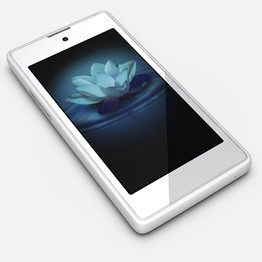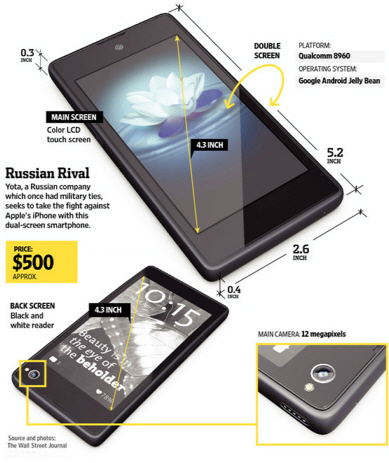Yesterday we wrote an article that notes quite clearly that the tablet is killing off the eBook reader. The eBook - or rather true eBooks, by which we mean those that make use of electronic ink/electronic paper display hardware (such as the original Kindles and the current Amazon Paperwhite Kindle) and not tablets sold to provide reading capabilities, is interesting because of its extremely long battery life.
The Paperwhite, for example, will go three weeks without needing a charge (it would be even longer if the Paperwhite didn't also provide a light source for better night time reading). The reason for this is that electronic ink/electronic paper displays only use power when they are flipping through pages - when a user is sitting on (reading) a page no power is consumed.
In any case, the tablet is still killing off the eBook regardless.
So imagine our surprise when we learned yesterday evening - in an article published by the Wall Street Journal, that a Russian company by the name of Yota Devices is suddenly becoming hot for having developed a potentially hot new smartphone that features the usual power-hungry LCD smartphone display but will also offer, on the flip side of the phone, a second display based on the hugely power efficient electronic ink technology. Quite honestly our initial reaction was - and still is - that this is a rather very cool idea! So perhaps eBooks will live after all, only in a slightly altered form.
"We created this to be different," noted the company's 43-year-old chief executive, Vladislav Martynov, while demonstrating a prototype. "Most phones nowadays are boring—they are just boxes. This is a phone for people who want to be outside that box."
Yota believes - and is betting heavily on this belief, to the tune of $25 million dollars and a team of 35 engineers - that once the new dual-screen smartphone is released it will disrupt the mobile technology and smartphone market. The device will be powered by Android. Will it be the latest Jelly Bean version of Android (which Samsung's Galaxy S III has finally just been upgraded to)? Who knows?
The company's current plans call for the new smartphone - which doesn't yet have a name - to be officially unveiled at Mobile World Congress 2013 in Barcelona in late February. Yota anticipates that the device will then become available for sale in Russia in Q3 2013, probably for about $500. In the best of all worlds, Yota would then see the dual-screen smartphone go international in Q4 2013 just in time for the holiday buying season. There is no harm in dreaming a dream!
Nifty Design?
Carolina Milanesi, an analyst at Gartner points out that "The mobile phone market is a lot about brand and fashion, so competition will be tough." And if the Yota device turns out to be heavy and thick it will be dead in the water. But there are some images available, one of which is shown immediately below, that suggest Yota has thought this through. Milanesi also notes that the phone may indeed find fans as it could "solve a problem by allowing people to have access to what information they care about most."

If the image above bears any semblance to reality it certainly would be able to play with Apple and Samsung. Martynov realizes the magnitude of the challenges his company faces in even getting the device out the door, but he believes that in offering the dual screen - and more specifically a dual screen that takes advantage of electronic paper technology - gives him an edge. He notes that the major players "haven't brought a lot of innovation to the game in the past five to six years."
What can a user do with an e-paper display? Here's one: users will be able to continuously view all kinds of streaming data in real time, from Twitter feeds to stock market tickers and endless other data sources without having to constantly wake their smartpphones up from LCD screen sleep mode. The info may be constant, but it won't drain the phone's batteries at anywhere near the rate LCDs do, even for information that may change frequently (remember, e-paper uses power when the screen info actually changes or updates).
As with eReaders, the e-paper screen will display only in black and white but users will still be able to view crystal clear photos, maps, airplane boarding passes and so on. As with eBook displays, should the power run out, the image or page currently on display will remain visible. Martynov also points out that the display can also be customized in any number of ways to deliver any information a user or an app wants delivered.
According to the Wall Street Journal, other unique elements include a curved display on one-side, using a first-of-its kind rounded glass from Corning. The design idea here is to encourage users to always point the e-paper screen up when putting the phone down. The screen is only partially touch-sensitive, with color and a full touch-screen a possibility for later generations. Also by way of the WSJ comes the following detailed image - to be honest, it's a rather handsome looking device.

The smartphone is the first for Yota, which has seen its primary success in developing 4G networks in Russia and in selling modems and wireless routers. Yota intends to produce the device itself, and plans to bring it to market through contracts with a variety of global carriers, which they are currently working to cement. Production of the devices - certainly there is no surprise here - will be done in Asia by tier-one suppliers, Martynov says.
E Ink, which worked with Yota to develop the e-reader aspect of the phone, said this was the first fully-integrated phone of its kind. "This is a whole new segment and innovation in the marketplace," says E Ink's chief marketing officer Sri Peruvemba. "They have designed a product that we believe will have a lot of traction in the market."
It may very well gain that traction. We know we want one! We have had plans to purchase an Amazon Paperwhite, but maybe now we'll hold off.
Edited by
Amanda Ciccatelli